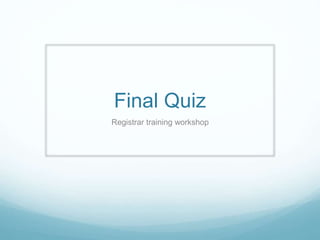Lung Ultrasound - Final Quiz
- 1. Final Quiz Registrar training workshop
- 2. But first a recap
- 4. A lines do not define pathology A lines may exist in normal lungs, pntx(if there is no sliding), COPD or PE Make sure probe is perpendicular to lung surface (not skin surface)
- 5. B- lines ║▌║▌▀Ż briskly from thin pleura edge. Extend to bottom of field. Three per field = ŌĆśwet fieldŌĆÖ. Two wet fields per side suggests CCF- particularly if symmetrical FLASH APO is often apical, subclinical is laterobasal.
- 6. Wet PLUS= B lines with thick wrinkly pleura. ŌĆśc patternŌĆÖ
- 7. Sub pleural abnormality = small collapse May indicate small PE, mets or infection. ║▌║▌▀Żs with respiration. Suggest refer to German papers for subgrouping.
- 8. Hepatisation (wet OR dry) Hepatisation generally indicates major collapse/consolidation.
- 9. And there are other less frequent findingsŌĆ”.. ŌĆścurtainŌĆÖ & ŌĆśjelly fishŌĆÖ sign
- 10. Quiz instruction ’éŚ Right lung, 4 regions, on first slide ’éŚ Left lung, 4 regions, on second slide ’éŚ Choose between subsequent CXR (A or B) ’éŚ Added extras later on.
- 11. Case 4 RIGHT LUNG
- 12. Case 4 LEFT LUNG
- 13. XRAY A
- 14. XRAY B
- 15. Case 5 RIGHT LUNG
- 16. Case 5 LEFT LUNG
- 17. XRAY A
- 18. XRAY B
- 19. Case 6 RIGHT LUNG
- 20. Case 6 LEFT LUNG
- 21. XRAY A
- 22. XRAY B
- 23. CASE 7 ŌĆō RIGHT LUNG
- 24. Case 7 ŌĆō LEFT LUNG
- 25. XRAY A
- 26. XRAY B
- 27. Case 8- RIGHT LUNG
- 28. Case 8 ŌĆō LEFT LUNG
- 29. Case 8 Bonus slide
- 30. XRAY A
- 31. XRAY B
- 32. Case 9- RIGHT LUNG
- 33. Case 9 ŌĆōLEFT LUNG
- 34. XRAY A
- 35. Case 9 ŌĆō Bonus slide. XRAY B
- 36. Xray report. CHEST (AP/ERECT) History: IHT from Esk. SOB. Treated as pneumonia. Bilateral chest xray changes. Acute deterioration overnight, treated as APO. Findings: The heart appears moderately enlarged but the cardiac and mediastinal outline appears otherwise normal. There is bilateral alveolar shadowing throughout both lung fields with pulmonary venous congestion, and appearances are in keeping with acute pulmonary oedema but may also be due to infection. No pleural effusions are visible.
- 37. Case 9- bonus video BNP = 100
Editor's Notes
- #9: Hepatisation is simply an appearance that is ŌĆśliver-likeŌĆÖ on ultrasound, usually caused by consolidation of the lung abutting the pleural surface. Be aware that anterior view appearances may normal whilst still seeing hepatisation in the posterior, lower views.
- #10: Note the curtain sign, where the lowest portion of the lung slides across obscuring the diaphragm This shows you the lowest point of the lung, which we call a physiological lung point. It also indicates that this side of the chest is being ventilated (if you are checking endotracheal tube placement)




































